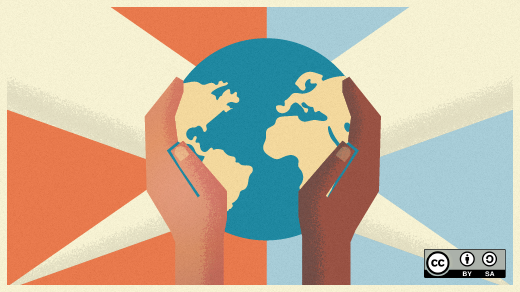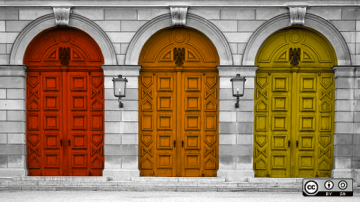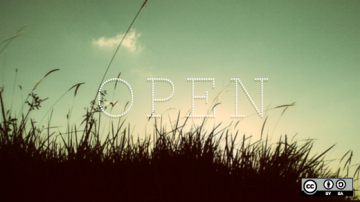For the past few weeks, collaborator Brook Manville and I have been offering our thoughts on (and analyses of) Johan Norberg's Open: The Story of Human Progress. My first article simply explained what the author means by the word "open." Thinking alongside Norberg now, I'd like to discuss future ways we might apply open organization principles to bring about prosperous societies globally. Norberg hints at such directions, but I believe further detail is required if we'll be able to set up action plans for the future.
The importance of inclusivity
One of the open organization principles, namely inclusivity, is extremely important when developing a more open society.
To highlight this importance, Norberg often asks readers to consider the differences between two groups or communities: an "inside" group and an "outside" group. When we consider people from our inside group, we see them as individuals. If we don't approve of one member, we limit our judgment only to that person. When we consider people from our outside group, or community, we see them as representatives of the whole group (forming a stereotype).
Here is where inclusivity becomes important. When the two groups interact, stereotypes can erode and both groups' members get seen as individuals. This doesn't mean the two groups become completely integrated; it just means each develops a deeper level of understanding about the other. And while differences are still apparent, joint interests emerge, too. Both groups can begin working together on efforts that serve them both.
To improve our inclusivity, we could ask how often people spend time with groups outside of or different from theirs. And does the group seem satisfied with that degree of contact?
Multi-dimensional group identities
When inside groups begin making more contact with different, outside groups, they begin to sew the seeds of more open global societies.
Naturally, we all are members of many communities, and we have many identities (which Norberg explains). Consider just a few: nationality, religion, race, political party, specialty/profession, language, educational level, and gender. Some of these dimensions of identity we have in common with others; other aspects of our identities differentiate us from others. By seeking common connections in the dimensions of our identities that we share, we can begin pursuing a better understanding of those "other" dimensions of identity that seem different to us. Problems arise when we identify too strongly (or too extremely) with only one facet of our identities, refusing to acknowledge the existence or importance of those different from us.
So how can we get people with such extreme, single-dimension identifications to be more inclusive?
"Tolerance" is a common theme in Norberg's work, but the concept on its own isn't sufficient for building open societies.
Steps to more inclusive societies
What Norberg calls "tolerance" is for me one aspect of a multi-part system of values that can help us create more open and inclusive global societies. I'd describe them like this:
- Recognition: We must first recognize the existence of other identities outside our own. This doesn't involve any kind of judgment about those identities, just acknowledgement of their existence.
- Respect: With recognition should come respect for those identities. It involves not just acknowledging others' existence, but validating it in some way. For example, say I travel to another city to meet fans of an opposing sports team. What I have to do is respect fans of that "competing" city's team—not determine whether that team is "bad" or "good," but try to understand why a person would be a fan of that team (particularly, say, if that fan grew up in that city).
- Understanding: This involves trying to understand what others are thinking and feeling. Here we begin to see others as individuals with unique histories and experiences that have led to the development of their identities. Simply put, we need to see the context others inhabit and understand how it might differ from ours.
- Tolerance: Norberg argues for greater tolerance of differences throughout Open. What he's describing here is the (occasionally uncomfortable) work of holding different identities in tension with our own. It takes effort. When I hear different perspectives, how do I respond? Am I overly defensive? Do I respond quickly or pause to consider his context? Do I ask clarifying questions to get a feeling for his thinking? These questions will help me become more tolerant of different and divergent perspectives.
- Optimism: Being optimistic is helpful for becoming open to differences. As Norberg notes, fear leads to pessimism, which narrows people's thinking and makes them look inward. It blinds them to others' perspectives. For instance, when giving sales seminars, I'd notice that people who were pessimistic about making sales had a harder time spotting the needs of the customer. They were too preoccupied looking inward. Optimism leads to thinking outwardly, which can lead to inclusivity.
- Patience: Finally, I think patience is also required to improve our ability to work through differences. When the differences are so great, the work of understanding those differences also seems great. It can feel easier simply not to do it. The best advice might just be to give yourself some time to think about the differences. After some time, a new perspective and better understanding might come to the surface. Patience is key.
Barriers to openness
Norberg stresses that most societies actually maintain barriers that prevent them from becoming more open. Barriers to growth and opportunities mean talented people will seek to join groups in societies where those barriers don't exist. Norberg offers several historical examples of this tendency.
But what are those barriers?
They relate to four types of mobility:
- Physical mobility: The ability to physically move where one wishes and away from a place or situation one wants to avoid is a form of physical mobility. How easily can a person or group move from one area to another in which they perceive more opportunity for growth?
- Professional mobility: This is the ability to move into different professions when the need for one's current professional skills are declining. How easily can a person or group develop new skills and adopt professions in higher demand?
- Social mobility: Are people or groups able to move to communities that promote their vision of human development—and away from communities that don't? How accepting is a community? How welcoming of new and different people? Can new ideas flourish here through discussions with newcomers?
- Psychological mobility: This refers to emotional desire or fear associated with moving to new and different environments and away from others. How psychologically adaptable and flexible is a person or group in general? Can people emotionally adjust to changes within their current surroundings?
Understanding these various forms of mobility can help a group or society learn how it can become more open.
Toward a more open world
As I've written previously, a more globalized society tends to be a more open society. Norberg clearly feels similarly, arguing that throughout history, when societies become more accepting of differences and open up, they tend to prosper, innovating and developing faster. It is due to openness, he says, that human civilization has progressed more in the past 200 years than it has in the past 20,000. Clearly, openness is important enough to warrant our efforts in helping it flourish.
In the end, Norberg's work stresses the importance of combining inclusivity with another open organization characteristic: collaboration. Future successes will rely, he says, on overcoming the idea that social progress involves a kind of "zero-sum game" in which one group's gains represent net loss for others. We should, he insists, be thinking of our work as "non-zero sum," even striving for a "plus-sum game," where one group's successes propel everyone forward. All groups have their own strengths and weaknesses; by working collaboratively, they can leverage each other's strengths far more effectively, increasing total benefit for all.
Openness, tolerance, recognition, and respect lead to increased trade, better division of labor, greater specialization, the quicker iteration and perfection of processes, and global understanding. As Norberg notes, openness helps new forms of expression, new ideas, new business models, and new insights circulate, leading to greater prosperity. Furthermore, Norberg notes that scientific advancement depends on open exchange of information, viewpoints, criticisms, and concepts. Isolation and restricted interaction, on the other hand, have historically led to failure—and will continue to do so in the future, should we not avoid them.









2 Comments